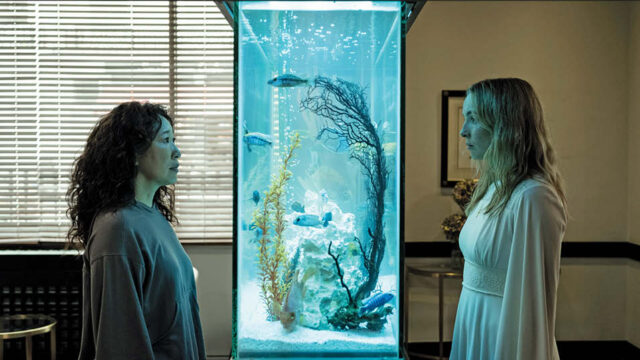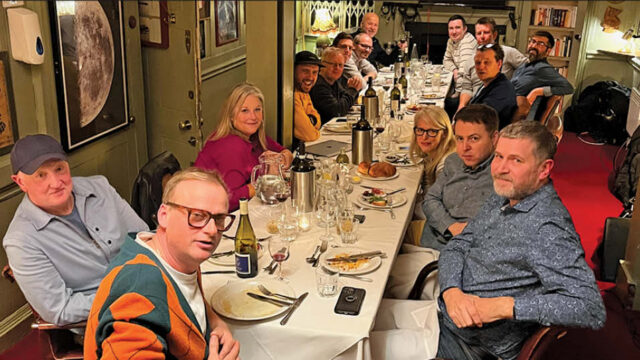On the evening of the 15th March, Televisual gathered together some of the post community’s finest business and technical experts to discuss the rapidly changing nature of post production and vfx. The evening dinner and discussion was kindly sponsored by Seagate Technology.
The debate took in multiple aspects of this change, with a strong emphasis on the cloud, but became more animated when the panel discussed Machine Learning, Machine Automation and Artificial Intelligence.
The Roundtable Panel included: Adrian Bull, ceo and founder, Cinelab Film and Digital; Fiona Burton post production and production technology specialist; Dave Cadle ceo and co-founder, Envy Post Production; Natascha Cadle creative director and co-founder, Envy Post Production; Zeb Chadfield chief vision officer and founder, The Finish Line; David Klafkowski ceo, Racoon; Adam Luckwell owner, Unit Studios and Miscellaneous Studios; Kevin McCue director of group production platforms, Sky; Tom Mitchell technical director, Mission; Andrew Palmer enterprise data and cloud solutions group, UK lead, Seagate Technology; Micheal Sienczak head of technical operations, Fifty Fifty Post; Rich Simpson managing director and co-founder, Hijack; David Thompson emea systems sales manager, Seagate Technology; Duncan Western co-founder, Splice Post; Tom Woodall director of post production, Molinare
All change please
SIMPSON: It all depends on how good AI really becomes. When I look at ChatGPT, OpenAi, DALL-E and Midjourney, they all hold such promise. The last time most of us felt like this about technology was probably when smart phones were first introduced.
MITCHELL: The problem with how we work today is that it’s an incredibly labour-intensive, manual process and involves a lot of top-level orchestration, whereas we mere humans can introduce error. We also seem to have a labour shortage. These amazing Machine Learning and AI tools have the potential to revolutionise how we work, from optimisation to building completely new tools and services. They were made possible due to the technology only being found in the cloud and being able to process huge data sets on custom silicone. The current travesty here is that in film and TV, workflow is predominantly not in the cloud and is therefore, for the most part, unable to leverage this.
I doubt most people aspire to filling out spreadsheets or copying data from a FileMaker Pro database into their vfx tool or watching render bars. We leave aspiring talent tied up for two to three years doing donkey work, almost as a rite of passage. Imagine if we can free these people up and have them doing what they are good at, doing what they really want to be doing. We would get people trained up faster and our talent pool would open up.
The film industry is ripe for a serious upgrade in how we are working, with new tools, tech, optimisation and AI/ML I would argue that we are about to see a bigger transition over the next 5 years than that of the impact we had when we moved from film to digital.
Next Gen
SIMPSON: In a traditional post facility model, there are staff waiting for people to die or move on. They’ve been sometimes working for ten years to get to the job they want. With media creation becoming more democratised – a lot of new technologies are already on our phones. People will be able to create higher quality images more easily. And in turn all these lower-level skills become increasingly redundant to a point where nobody will ever need them. Amateur filmmakers will not need them and will be coming in at a higher level and finessing, rather than grappling with the process.
CHADFIELD: When you look at younger adults, many of them are already using the skills that we have all learned over the years, so those skills are transferrable. In a way, maybe our job then is to figure out and transfer their way of operating into what we see as relevant, and our way of operating.

Where does ML, MA & AI have a role?
PALMER: Seagate uses AI a lot and it’s the low-level functions that we’ve automated, In our production processes, we pump out millions and millions of hard drives every day. We start off by digging raw materials out of the ground and then a year later – and 26,000 processes later – we produce the hard drive.
And every stage of that process is photographed. Using AI we compare it to a golden view of what hard drives should be. That way we can detect nuances within the design and when we make our ASIC devices, we can compare the actual product to what it should be. By doing so we can see when things are moving away from the high quality product.
This way we can intervene much sooner and before it goes into the field. It’s all the low-level stuff that a human couldn’t do fast enough that we use AI for.
WOODALL: What you’re describing is subjective. The whole point about speeding things up is that it’s binary, it’s either right or it’s wrong. The whole process that we intervene and interfere with is subjective. It’s creative. We like to have input because it’s neither right nor wrong where AI is currently binary.
BURTON: When making films or being creative, AI is helping us get rid of all the mundane technical stuff so we can be more creative. Things are going to get more complicated and we’re going to need that support. I don’t think there’s any sense in which we’re going to lose jobs.
KLAFKOWSKI: Over the coming years there will be more productions, producing more data, and production workflows will become more complex to manage. We need smart AI and ML tools to intelligently aid us in managing all this data and prevent the complex from becoming too complicated. Intelligent workflow and resource management application layers (like Tanooki) will enhance human creativity and not detract from or replace it.
We need to embrace these tools and not fear them, are you frightened of spell check? If used wisely, they liberate us from the mundane and allow truly creative thoughts and ideas to shine through.
MITCHELL: Although we always have to learn new skills, we are about to see the order of the underlying complexity go up exponentially. Take the mobile phone, there is no one person on this planet that can build one from scratch. No one knows it all!
And though a post house has a small team of engineers, the increasing levels of complexity will be too much for them to cope with. But that’s OK. Software and technology companies will build turn-key solutions that will abstract that away so post can focus on managing the talent and their clients. If anything, we’re looking at an easier and much less complex future for the facility. But the transition to get to that point will be a bumpy ride.
BULL: We have so much to gain from AI and ML. Although editing and grading could be automated for some genres already, there are so many other technologies that could improve efficiency and creativity that currently have minimal adoption. Facial recognition with emotion detection, object recognition, location and shot type are all possible and very much underused but could considerably improve the efficiency of working with both new and archive content.

Can grading be automated and to what extent?
CADLE (D): We’ve all got colourists that have different styles and approaches. You’d like some of it to be automated to take you to a point – and that might include colour correction – but they’re still going to have to finesse it. It would definitely make their jobs quicker and easier.
CADLE (N): The question is, where is that equilibrium point where the machine starts and the person begins.
BULL: There’s no doubt at all, that from an AI perspective, you can take a finished movie that’s 750 shots. You can look at all the main sequences and say, ‘okay, this is how I want that interior to look, based on the lighting that’s there’ and there is absolutely no doubt AI can do the analysis of the rest of the clips and identify the same sequence and the same scene. But there is a decision that needs to be made about the storytelling within grading – which is a step forward from AI – to understand that, for example, the emotion in the film is getting darker rather than the emotion being consistent.
So, yes that colour correction aspect and making sure everything looks technically correct is possible. The second stage of grading – which has evolved significantly over the last 15 year with the technologies that we have available – is adding the emotion and creative look and taking the viewer on an emotional journey through the use of light and colour.
MCCUE: Let me play it back in quite a different way. I think we’re getting into the debate on something that’s cost a lot of money to make and trying to devalue something that has a low cost within the value process; that isn’t going to draw attention. So, let’s say that within the $300 million movie, they spend a million dollars grading it. You’re not going to AI that out. There is limited value in trying to pool these processes out.
Let me talk about the other end of the market. Say, I’ve got rights to the Premier League, I’ve got rights to all the different levels of the EFL, Scottish football and women’s football. And I want to super-serve clips to all my viewers. I want to make this value-added application where every time your team, or a team you’re following, scores, you would get zapped on the phone. Can I afford to have an editor sitting in the suite watching one match, clipping and publishing based on that level of personalisation? No, I can’t afford to do that. Can an AI engine do that for me and also publish that to the customer? The ability to deliver hyper-personalisation makes 100% sense and it has commercial value.

Are films and TV shows going to be completely produced within a games engine?
SIENCZAK: It’s a tool in the kit box to make the previews better. It is getting increasingly easy to produce films entirely based on vfx. But I don’t think there’s any interest from people paying to watch a film with say, Tom Cruise, to see him being animated. People go to the cinema to see Tom Cruise act.
LUCKWELL: It’s not going to have an immediate impact on post production. You might want to storyboard a film so that you can test run it in front of an audience. Let’s say it’s going to cost the studio a million dollars, and they can write that off as an investment. That’s not going to have any impact on the post market. You’re still going to spend the $300 million on the movie.
CHADFIELD: Film and television production has always been a technology driven business and that won’t change. Companies will continue to adapt or die as they always have. And we’ve got to be willing to cannibalise our own markets, because that’s part of the process of development. It would be idiotic to believe AI won’t have an impact on the business and it already is having an impact in many ways.
The market and services provided right now are different from what they were five years back and different again from five years before. All that we have seen happen is content production accelerating and more space opening for different niches. That will continue and I believe all the facilities that have an eye on the tech and the capacity to invest in
it will evolve to utilise it.
Or vanish.
MITCHELL: There’s nothing wrong with any of the changes we’re experiencing now and the development of new things that haven’t existed before. As an industry, we have always adapted. The only problem is that if people don’t embrace those changes, they can only fall behind.

SEAGATE
An Integrated Storage Solution from Camera to Cloud
With more than 40 year’s experience, Seagate’s product range has delivered a core technology stack that brings hyperscale cost and end-to-end architectural efficiencies to the enterprise across software, silicon, system, and device innovations. Seagate Storage solutions were designed with M&E in mind and directly address the data management challenges from camera to cloud.
With Seagate Lyve, you can freely access your post-production media from any environment and achieve long term cost predictability. On-Prem or Lyve Cloud content repositories offer advanced CAPEX or OPEX solutions with no ingress, egress or API fees. Seagate offers block and object storage with superior value. Seagate storage products help you to store, protect and transfer valuable media assets across any environment (on-prem and in the cloud), wherever it is needed. Vertical integration with Seagate offers cost advantages and can help you reduce significant TCO when compared to solutions that aggregate storage providers.
Furthermore, managed migration by Lyve Cloud supports hassle free onboarding of the data to the cloud and provides easier and faster content retrieval.
With Seagate there is no compromise on performance to meet your goals – reduce costs while keeping your media in a highly available (99.9% availability), super durable (> 11 9s), reliable and truly confidence inspiring combination of storage solutions.
We Craft the Datasphere.
James Bennett
Share this story


















